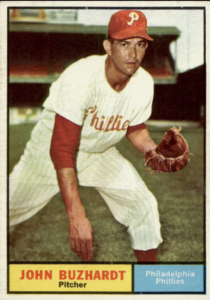This is not an earthshaking blog topic, but the kind of hardball coincidence that catches Baseball Roundtable’s attention.
 On July 28, in the second game of a doubleheader, Phillies’ righty John Buzhardt picked up a victory – going the distance as the Phillies topped the Giants 4-3 in Philadelphia. Over the next 22 days, the Phillies lost a still-MLB record 23 consecutive ballgames. (Remember single-admission doubleheaders).
On July 28, in the second game of a doubleheader, Phillies’ righty John Buzhardt picked up a victory – going the distance as the Phillies topped the Giants 4-3 in Philadelphia. Over the next 22 days, the Phillies lost a still-MLB record 23 consecutive ballgames. (Remember single-admission doubleheaders).
Then, on August 20, again in the second game of a doubleheader, they broke the losing streak. And, again, the winning pitcher was Buzhardt – who gave up four runs in a nine-inning complete game as Philly prevailed 7-4 over the Braves in Milwaukee. So, Buzhardt’s two wins were the bookends holding the 23-game losing streak in the middle. Oh, and what number was Buzhardt wearing? Twenty-three, of course.
Buzhardt’s August 20th win, not only marked the end of the Phillies’ record losing streak, it also marked the beginning of the 1961 Phillies’ longest winning streak. From August 20-25, the Phillies won four in a row. The last winner in that Phillies 1961-best winning streak? You got it. Once again, John Buzhardt with a 9-4 complete-game victory over the Braves.
Buzhardt, by the way, finished the season as 6-18, 4.49. (Those six victories, however, were second most on the team (Art Mahaffey went 11-19, 4.10). And Buzhardt did take three of the losses in the 23-game streak. It was not all his fault, however.
A few points to consider.
That 23-game losing streak – during which the Phillies were outscored 133-54 – was part of a 47-107 season that saw the Phillies finish in last (eighth) place – 46 games off the pace. In the campaign, they scored the NL’s fewest runs (584), and gave up the second most (796) – versus the league average of 700 in each category. They also had the league’s highest earned run average (4.61 vs. the league average of 4.03) and lowest team batting average (.243 vs. the league average of .262). During the 23-game losing streak itself, the Phillies scored two or fewer runs 16 times. A few other notables about the streak, it included:
- 18 road games and just five home games;
- Seven one-run losses;
- Three doubleheader sweeps;
- Four shutouts’ losses, three in consecutive games;
- and a 31-inning scoreless streak.
Side note: During the season, the Phillies lost 35 one -run games (19 wins), were shut out 15 times and were held to two runs or less 67 times.
The Phillies finished the dismal 1961 season with a phlourish. In their final four games, all at home, they were outscored 33-6, but still managed one win – a 2-1 victory over oaf all pitchers), the Dodgers’ Sandy Koufax.
Now, let’s get back to John Buzhardt. In his two seasons with the Phillies, the team went 106-202-1. In those two seasons (1960-61, Buzhardt went 11-34, 4.18 (and those 34 losses represented just over 35 percent of his total losses over an 11-season MLB career). Pitching “not for the Phils,” Buzhardt was 60-62, 3.47. For his career (1958-68 … White Sox, Phillies, Cubs, Astros, Orioles) Buzhardt he was 71-96, 3.66. Buzhardt’s two best seasons were 1964-65, when he went 10-8, 2.98 and 13-8, 3.01 for the White Sox.
Again, not a particularly earthshaking post, but I do like the fact that victories by number-23 bookended the Phillies’ record 23-game losing streak.
Primary Resource: Basevall-Reference.com
Baseball Roundtable – Blogging Baseball Since 2012.

 Baseball Roundtable is on the Feedspot list of the Top 100 Baseball Blogs. To see the full list, click here.
Baseball Roundtable is on the Feedspot list of the Top 100 Baseball Blogs. To see the full list, click here.
Baseball Roundtable is also on the Anytime Baseball Supply Top 66 Baseball Sites list. For the full list, click here.
I tweet (on X) baseball @DavidBaseballRT
Follow Baseball Roundtable’s Facebook Page here. More baseball commentary; blog post notifications.
Member: Society for American Baseball Research (SABR); Negro Leagues Baseball Museum; The Baseball Reliquary.
P1031






Speak Your Mind